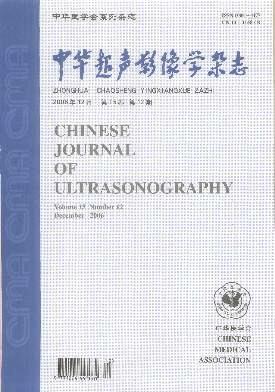Evaluation of left ventricular systolic function and synchrony in patiests with early left breast cancer after breast conserving radiotherapy by layer-specific strain technique
Q4 Medicine
引用次数: 0
Abstract
Objective To evaluate the left ventricular systolic function and synchronization of patients with early left breast cancer after breast conserving radiotherapy by layer-specific strain technique. Methods Thirty-six patients with early left breast cancer who underwent breast surgery and radiotheraphy in Affiliated Tumor Hospital of Zhengzhou University from January 2018 to January 2019 were selected for this study. The layered strain technique was respectively applied to collect two-dimensional dynamic ultrasonic cardiograms one week before radiotherapy, one week after radiotherapy, and six months after radiotherapy. The EchoPAC 201 software was applied to analyze and obtain the global longitudinal peak strain(GLPS) and peak stain dispersion(PSD) of the epicardial layer(epi), the middle layer(mid) and endocardial layer(endo) of 17 left ventricular segments. The differences of every parameter before and after radiotherapy were compared, and the correlation of PSD and other parameters was analyzed. Results Compared with one week before radiotherapy, the absolute values of LPSepi, LPSmid, LPSendo, and GLPS all reduced significantly one week and six months after radiotherapy, and PSD increased significantly (P<0.05). Compared with one week after radiotherapy, the LPS absolute value of every layer and GLPS obviously reduced after six months, PSD obviously increased, the difference had statistical significance (P<0.05). PSD and GLPS displayed negative correlation one week after radiotherapy (r=-0.420, P<0.05), PSD and GLPS displayed negative correlation six months after radiotherapy (r=-0.641, P<0.05). Conclusions Layered strain technique can noninvasively and quantitatively evaluate the early changes of global and layered longitudinal peak strain and systolic synchrony of left ventricle in left breast cancer breast-conserving radiotherapy patients, and provides a new noninvasive test method for evaluating radioactive myocardial injury, and it has a certain guiding value to early clinical intervention and treatment of cardiovascular complications. Key words: Breast cancer, early; Radiotherapy; Layer-specific strain; Peak strain dispersion层特异性应变技术评价早期左乳腺癌保乳放疗后左室收缩功能及同步性
目的应用层特异性应变技术评价癌症早期保乳放疗后左室收缩功能及同步性。方法选择2018年1月至2019年1月在郑州大学附属肿瘤医院接受乳腺手术及放疗的36例早期左乳腺癌症患者进行研究。应用分层应变技术分别在放疗前1周、放疗后1周和放疗后6个月采集二维动态超声心动图。应用EchoPAC 201软件分析并获得17个左心室节段的心外膜层(epi)、中层(mid)和心内膜层(endo)的整体纵向峰值应变(GLPS)和峰值应变分散度(PSD)。比较放疗前后各参数的差异,分析PSD与其他参数的相关性。结果与放疗前1周相比,放疗后1周和6个月LPSepi、LPSmid、LPSendo和GLPS的绝对值均显著降低,PSD显著升高(P<0.05),放疗后1周PSD与GLPS呈负相关(r=-0.420,结论分层应变技术能无创定量评价癌症放疗后6个月左室整体、分层纵向峰值应变及收缩同步性的早期变化,为评价放射性心肌损伤提供了一种新的无创检测方法,对心血管并发症的早期临床干预和治疗具有一定的指导价值。关键词:乳腺癌症,早期;放射治疗;层特异性应变;峰值应变分散
本文章由计算机程序翻译,如有差异,请以英文原文为准。
求助全文
约1分钟内获得全文
求助全文
来源期刊

中华超声影像学杂志
Medicine-Radiology, Nuclear Medicine and Imaging
CiteScore
0.80
自引率
0.00%
发文量
9126
期刊介绍:
 求助内容:
求助内容: 应助结果提醒方式:
应助结果提醒方式:


